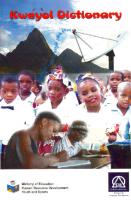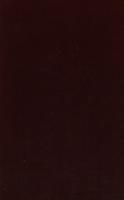Setswana-English-Setswana Dictionary [4 ed.] 9991277773, 9789991277776
2,157 181 42MB
Setswana (Tswana); English Pages 647 [678] Year 1993
Recommend Papers
File loading please wait...
Citation preview
Ail
|
|
)
btn
i
ia
‘i \
:
@
:
|
|
|
oa
|
|
|
| English —
| | |
|:
|
‘Setswaarnya
D| iction | ‘
Setswana
English Setswana Dictionary
Compiled
by Z I Matumo
= —) =a oa) ane
Setswana-English-Setswana Dictionary © Botswana Book Centre 1993
All rights reserved. No reproduction, copy or transmission of this publication may be made without written permission. No paragraph of this publication may be reproduced, copied or transmitted save with written permission or in accordance with the provisions of the Copyright Act 1956 (as amended). Any person who does any unauthorised act in relation to this publication may be liable to criminal prosecution and civil claims for damages. First published 1875 Second edition 1895
Third edition 1925 With new Preface 1965 Reprinted 1968, 1971, 1973, 1978, 1979, 1980, 1982, (twice), 1985, 1986, 1987 Fourth editon 1993 Published by Macmillan Botswana Publishing Company (Pty) Ltd P O Box 1155, Gaborone, Botswana and
Botswana Book Centre P O Box 91, Gaborone, Botswana
Typeset in Times Roman by C A North & Partners Cover design by Robin Stuart-Clark
ISBN
999 12 77773
150th
YEAR
MACMILLAN
Printed and bound by Interpak Natal
\
)
|
Contents sete iv Acknowledgements (Maleb0go) -.rvsssssssssssessssssecsssssssssssssscecsnnnersrsssscscennnnsessesseetenn
v Foreword (Ketapele) ..ssssssssssssessssssscsssecssscesutsssssnecssnscssnecessnsecanecsansensnnsanaasassessnesenaneensenanseges PLEfACE
tenia vii cessssessesssecssccsessnecsscssesssssncesscsnecsnecneesnecueesecssssasesscensensecnenscnnecanenses di csepeeniac
Introduction
Classification COMCOTAS ceesssssssssessessssssssecuecsccsssssescssceneenceucsnecneensenseneensenscseenecsssecsecnncenecnsacansansenenscgsesegsesees
Vowel system COMSOMANHS
cessssssscsesssseessssssneseesssscsecseesesecneansaseneensesessacensnesnecseneneeueanens
Demonstratives
AGjectives ..sssssssssssssssssssssssssssssssnnssssssseseessssssssssceeeecencrenecnnenssnssnsnnnsnnnssssscnssqqgeqqggenesansantt EMUMETAativeS
ceccsssssssssscssessssscssccsccsscssccsssscssessessscaeseesecneenseenssessssscesecanenensssecneenaseneaanseness xviii
Quantitatives Possessives Relatives A guide to pronunciation Abbreviations .....cccsscsssesssesssscossececsecesssscsesessssesssseseseeseneseensncasesansnsssenensseneneneneeneaens® Setswana—English English-Setswana
NS —EEEeEeEeEeEeEeEeEeEeEeEeeee=>aPeeeeOOeee
ili
Malebogo
Nna montShafatsi wa thanodi ya ga Tom Brown, ke dirile ke le mokotedi fa maina a a tlaa latelang fa tlase e ne e le bone bagami.
Dikakgelo tse di thusitseng ntShafatso ya thanodi di amogetswe mo lobakeng lwa dingwaga di le mokawana. Ke ka moo go dirang gore mo go boleleng maina a bathusi go iphitlhelwe go sa kwalwa, mme e se ka maikaelelo maina a mangwe a a ka beng a lebalesegile, e tswa tse ba nontshitseng tiro ka tsone di itshupa. Jalo he, fa la gago leina kana la mongwe wa gago le sa tlhaga, itse fa selekanyo sa malebo a a lebisiwang koo go wena € ntse ¢ le sone sele sa ba maina a bone a kwadilweng.
Ke boitumelo jo bogolo go iphitlhela ke abetswe go isa ditebogo go boRre S.M. Gabatshwane, M.U. Leinaeng, B.C. Leshoai, K.M. Masogo, J.R.M. Seboni, C.I.B.
Sekgwa, O.M. Gaborone le N.L. Mompei. Malebo a isiwa le go baswi boRre G.K.N. Kgotlana, B.C. Thema le E.S. Moloto. Botlhe ba ke borre ba e rileng go dumalana ga bone go tsaya dipokisi di tletse dikarata, ba ya go baakanya le go tokafatsa dilo ka fa temogong ya bone, mme ba fitlhela e le tiro e e tlhokang gore ba nne bomoya-goleele o lefang ka marapo, Teu ya setlhopha se, e ne e tshwerwe ke Rre M.L.A. Kgasa ka sebele. A di eme jalo ka dijokwe. BoRre M.U. Leinaeng le R.D. Molefe ba tshwaragane le Mme A.S. Sefudi ba ne ba dira ka botlhaga dipatlisiso ka ga mangwe mafoko a a adimilweng mo ditemeng di
sele le mangwe a Setswana sele sa lekgorokgoro. Maiteko a bone a supile fa ba tlotla puo. Go bone ra re mabele a bommaalona ga a na a jewa ke tshupa.
Bommankgekge ba dingaka: G.H. Teichler le A.M. Merriweather ba nnile le kgatlhego mo go ntShafadiweng ga thanodi mo ba sekileng ba ipona tsapa le go nna le seabe. Wa ntlha ene o ne a rolela bantShafatsi mafoko a a kopaneng nao a itebagantse le puo ka bophara fa yo mongwe ene a ne a letlelela gore go adimiwe mafoko
a a kayang malwetsi le tshidilo ya one. Re lo rolela dipuana borra! Moswi Moruti Alexander Sandilands’ o supile ka ditsela di le mmalwa maitemogelo a gagwe gore puo ya Setswana e na le mantlontlo a a e faphang. Thanodi e okotse lobebe fela la ka fa Motswana a kgonang go go kaela mebala ya kgomo le bong jwa yone ka tiriso ya lefoko Je le lengwefela. Robalelwa ke ditlhokwa tlhe rra!
~
SABA
ABS
WLALAAABY
' Ketapele
Lokwalo lwa ntlha lwa thanodi ya Setswana lo rulagantswe ke Moruti Tom Brown mo dingwageng tse jaanong di setseng di feta lekgolo. Lwa bobedi lo rulagantswe ke
Morulaganyi Kgasa e seng bogologolo thata. Lokwalo lo, mo thanoding ya puo ya Setswana jaanong ke lwa boraro. Mme lokwalo lo ga lo a tla go seegela tse dingwe tse di setseng di boletswe tse di etelelang lo pele fa thoko. Lo tshwanetse go lejwa kana go tsewa € le lo lo tlileng go di oketsa. Jaaka sengwe le sengwe se sa eme golo go le gongwefela, jalo he le puo, le yone ga e salele kwa morago; bogolo jang ka ke yone megopolo kana ditogamaano tse ditlha-
bololo di tshwanetseng go utlwisiswa ka yone. Mme e re jaaka puo e gola ka go adima mafoko a diteme di sele go bo go tshwanetse gore le dikwalo tsa thanodi di nne
di kwalwe gape di godisiwe kana di baakanngwe seSa. Le fa lokwalo lwa thanodi tota lo tshwanetse go balwa ke mongwe le mongwe, a lokwalo he lo lebaganngwe le baithuti ba bagolo, e bong bana, ka gore kwa ntle ga gore ke bone ba ba nang le nako ya go bala thata, e bile gape ke bone ba tshwanetseng go tlhoafalela go ithuta Setswana, ka e bile ke sone se se re bopagantseng bogolosegolo, re le setShaba.
Setswana se ile sa salela kwa morago thata mo go kwalweng, ka ntata ya gore Batswana ga ba a tlwaela go kwala thata jaaka batho ba ditShaba tse dingwe. Lebaka le lengwe e ne e le gore bagatisi ba dikwalo ba ile ba tlhoka kgatlhego kana ba nna bonya mo go gatiseng dikwalo tse di itebagantseng le Batswana ba Botswana, mme ba kgothatsa go balwa ga dikwalo tse di kwaletsweng Batswana ba Aferika-Borwa. Gape, le baeteledipele ba thuto le one mmuso tota ba ne ba seka ba kgothatsa tlhabo-
lolo ya Setswana go sale gale. Mme le fa go ntse jalo re bona kgatlhego mo Setswaneng e ntsifala le bakwadi ba dibuka tsa Setswana ba ata. Jaanong e bo e le yone nako ya gore e re fa motho a bala dibuka tse di mefutafuta tse, a bo a ntse a na le tha-
nodi go lebisisa mafoko a a sa a utlwisiseng sentle kana a e leng lwantlha a a bona. Ba Khansele ya SetShaba ya Puo ya Setswana ba isa malebo mo go ba ba rulagantseng lokwalo lo lwa thanodi. Bogolo jang e leboga Rre Z.I. Matumo, yo kgatlhego
ya gagwe mo Setswaneng e tswang kgakala, mme e bile a ise a ke a itshupe tsapa ka
——
’tsatsi lepe. E bile go lebogwa le ba Botswana Book Centre le ba Macmillan Botswana Publishing Company ka fa ba tshwaraganetseng tiro ya go baakanyetsa kga-
tiso ya lokwalo lo ka teng. Khansele ya Setswana ka bojosi, e ile ya supa kgatlhego e kgolo thata ya ba ya kgothatsa gore lokwalo lo lo tlhwaafalelwe lo bo lo nne teng. E
bonye fa paakanyo ya lokwalo lwa thanodi e le kgatelopele mo ditlhabololong tsa puo ya Setswana e le ruri. Ke solofela fa lokwalo lo tlaa sologela setShaba molemo.
ibe Keetla M. Masogo
YO O NENG E LE MODULA SETILO WA KHANSELE YA SETSHABA YA SETSWANA 1993
vi
Preface
available Setswana is a beautiful and subtle language. Until 160 years ago it was not an oral of demands the of interplay the by in written form, and its development was
situation in which euphony is a paramount force. This is not to say that Setswana has no grammar, or that it has merely a crude gram“Hints to mar. In the introduction to the 1895 edition of his dictionary, entitled accordlearners of Setswana”, John Brown wrote: “It is not easy to teach Setswana
difficulting to the rules of grammar, and those who try so to learn it will meet with ies.” But which rules of grammar? In all languages there are certain basic elements, qualias well as a need to communicate about facts, things, people, actions, features,
ties, etc., but the genius of the African languages is the economical and intriguing way in which a root word or particle can be permutated through verbal, nominal, adverbial and adjectival functions into forms far removed from the starting point. It is , However, every change along the route is in accordance with inflexible rules. the For not a defect in a language when it goes spiralling off into new directions. this learner it is rather a delight to discover and a continual pleasure to experience consistfeature of Setswana, and the principles of the language form a precise and
ent grammar. The crucible in which the language was refined was provided by the various public occasions which called for more than the usual virtuosity in the use of the spoken the ward word. The democratic process of discussion and decision in the family, in
and in the tribal kgotla gave great scope for subtle argument Batswana are an articulate people, and they respect those who speech to heights of beauty and poetry. The supreme example ge is in the praise poems composed in honour of the chiefs and
and inspired oratory. can raise the level of of this use of languaheroes of the tribe.
Here all the profundity of the rich store of proverbs is brought to bear, and epigrams and allusions form part of an intricate design which is the delight of every Motswana of ~and the despair of the foreigner who has laboured long to learn the mere words the language but has never achieved insight into its hidden treasures. At the same time Setswana is an excellent vehicle of communication on practical
matters. In his preface John Brown also wrote: “In some respects the Setswana language is very rich in words . . . On the other hand there are respects in which the language is decidedly poor.” There is surely nothing strange about that. The vii
ar 7
language is very strong in the areas of major importance to Batswana. Traditionally they are a semi-nomadic people practising cattle farming, with the farming of arable
land and hunting as supporting activities. The terminology of these areas of interest is therefore both extensive and precise. For example, the terms used to describe
cattle form a remarkable vocabulary of single words covering a wide range of re-
cognition features such as height, build, colour, markings, horns, etc. But Batswana are part of the wider world, and are also experiencing the rapid mo-
dernisation and urbanisation that is common these days. Easy travel opportunities and the far-reaching media subject them to the pressures of other cultures and
languages. New machines and new concepts, even old concepts in new dress, constantly spawn new terms, and Setswana needs to cope with this. Western man turns to his Greek and Latin linguistic roots, and we have telegrams (G) and automobiles (L) and even television (G-L). How are Batswana to cope with man’s inventiveness? Among scholars the argument is between the advocates of borrowing and of coining.
The former point out that the exotic commodity arrived complete with a name, so why not call it a mmotorokara? The latter stand for using genuine Setswana elements in imaginative ways to create a word for an imported concept, so what
about sejanaga? The former solution offends the purist, while the latter has the dis-
advantage that the coined word itself needs to be explained. The controversy is liable to continue, probably indefinitely. It is into this situation that we launch the fourth edition of the dictionary. Its core material is the third edition, published in 1925 by Tom Brown. The whole of the earlier dictionary has been reviewed. The most obvious change is in the orthography, but there has also been a careful study of the definitions and a revision of the grammatical apparatus in terms of the current understanding of the language. Supple-
mentary material was received from a number of sources, and of course this includes words from both the borrowers and the coiners. The result is set out as a descriptive dictionary. Even to try to be prescriptive in the tradition of Dr Johnson would be presumptuous in these days when so many and various forces are at work at developing the language. The Setswana—English—-Setswana dictionary, fourth edition, stands in a tradition
which goes right back to the days when an orthography was first devised for the
language. In 1830 Robert Moffat published a Setswana version of the Gospel of St Luke, and at the back offered two pages of explanations of the more “difficult” words. Is it fanciful to regard this as the first small germ of a dictionary? In succeeding years, Moffat, Edwards, Ashton, Hughes, Livingstone, Price and others produced
wordlists as they worked on their translations and publicatons, but the first published dictionary of which the Botswana Book Centre has record is that of John Brown in 1875. He brought out a revised and enlarged edition in 1895, and this was incorporated into Tom Brown’s dictionary in 1925. This has been used until now. All the
compilers of the different editions placed on record their deep indebtedness to their viii
Z
Batswana colleagues and friends who helped and guided them in teasing out the meanings of the words listed. The materials available for the present edition included a long list of words by Alex-
ander Sandilands. Others have contributed lists, some from specialised fields. Alfred Merriweather’s research in the medical field has been very helpful. Of course, the most significant development during this century has been the responsibility for researching the Setswana language which has been shouldered by Batswana scholars. Following in the footsteps of pioneers such as Solomon Plaatje and M.O.M. Seboni, there are now many people qualified to analyse and explain the language. A number of them have been involved in the preparation of this new edition, and their names
are mentioned in the Acknowledgements. Special mention should be made of Morulaganyi Kgasa, who advanced the work during the seventies. The BBC finally entrusted the preparation of the manuscript to Z.I. Matumo in 1985, and his sensitive scholarship and close attention to detail are reflected on every page. The scope of the dictionary has also grown under his hand. Most of the work on the previous editions was done within the functions of the London Missionary Society, related to its publishing operations at Kuruman and Tigerkloof. This aspect of the work of the Society has developed into the Botswana Book Centre at Gaborone, a direct descendant of the Tigerkloof Book Room. It. was in
exercising this responsibility that the BBC made sporadic attempts to prepare a fourth edition, and eventually engaged the services of Z.I. Matumo. Although the
BBC could have published this edition alone, the work would undoubtedly have taken some time, so we were glad to accept the offer of technical, editorial, financial
and marketing help from Macmillan, and have enjoyed working with them. This dic-
tionary is therefore issued as a co-publishing enterprise.
The co-publishers present the new edition in the hope that it will prove a worthy successor to the previous editions, and at the same time a significant contribution to Setswana lexicography.
J. Derek Jones
Botswana Book Centre Gaborone, 1993
OOO’ ped
Introduction by the Compiler
I am as conscious as anyone else that there are shortcomings in this dictionary. Language is a fluid and developing organism, and a dictionary freezes it momentarily so that its vocabulary can be studied. This means that in an important sense a dictionary is already out of date on its day of publication. In the case of this one, certain other factors need to be taken into account, and this Introduction is intended to
mention them briefly. It is my immediate aim to help users of the dictionary to find their way around in it. I also hope that an understanding of these matters will encourage readers to make suggestions for its improvement. The material is on computer, so adjustments can be incorporated easily, and this will make the dictionary an in-
creasingly valuable tool in the hands of its users, edition by edition. Vocabulary:
The most obvious way the dictionary will develop is by the addition of more words. We already have a small list of words for inclusion in the next edition, and we look forward to obtaining more from our readers as well as from our own researchers. Experience has shown that many newcomers to Setswana have failed to find words in the dictionary by Tom Brown because they did not know the verb patterns of the language. This has led us to record as many forms of the verb as possible. Cataloguing various forms raises the problem of how to give specific meanings in each case, as there is no one-to-one correspondence of meaning between English and Setswana. A solution must be found to this semantic problem. Someone else may see it as intrinsic to African languages, which tend not to lack abstract vocabulary but the vocabulary of abstraction.
The compiler’s training — realises the grammatical English form, and from semantic meaning of the For example, in finding
or is it his intuition? — led him to think that once the user definition of a Setswana form, he will equate it with the there onwards try to puzzle out what is given under the Setswana form, feeling his way into the English meaning. the grammatical definition which states that a form is
passive, a non-Motswana is led into thinking of the simple form of the entry in question, and then moving into the way it would be expressed to bring out the
meaning of ‘passive’ in English.
M#WASBKAEEB 4 f AR RO ~w SAAS ~ARA
PS Transitivity:
Transitivity has been deliberately played down in this dictionary. Alphabetical listing of headwords:
This has led to what nearly amounts to duplication where nouns are concerned, in that a noun will show as an entry in its singular form, and perhaps show up again later in its plural form. Similarly, many derivatives tend to be regarded as nouns in their own right, and hence appear as nouns, while yet appearing similar to the verbal |
forms from which they were derived. Interjectives and exclamations appear as headwords in line with current grammatical thinking.
Entries that are listed as Arch(aic) and D(oubtful) should be regarded as open files that can still be altered by the findings of researchers. Structure of entries:
The headwords are printed in bold type. Grammatical definitions are abbreviated and printed in small capitals. Meanings appear in roman type. The meaning or senses of a word are separated by semicolons. Etymology:
In addition to what is said in the preface to this dictionary, it should be pointed out that not showing the origins of words has been a deliberate policy. Until problems that concern the trend that the language follows when borrowing have been solved, this dictionary will simply show entries as For(eign) in origin, without indicating the
language from which they are believed to have been taken.
|
I wish all readers success and pleasure in using this dictionary.
Hoc Z.J. Matumo Botswana Book Centre
Gaborone, 1993
i | ue
Classification lesser Nouns, adjectives, relatives, possessives, enumeratives, quantitatives, verbs, and to a
extent demonstratives and absolute pronouns, are classified according to their prefixes. The classification used in this dictionary is that of Carl Meinhof, which recognises 18 classes.
The class prefix of the noun that is the subject of the sentence, governs the prefixes of the adjectives, verbs, etc. that are found in the sentence.
The following are the various affixes that can be prefixed to the front of a stem: Class
NB
1
m-
mo-
la
Q-
2 2a 3 4 5 6 it
babomomelemase-
8 9 10
diNdin-
11 14
lobo-
15
go-
16
fa-
17
go-
18
mo-
ngw-
bmn-
ngw-
*me-
allomorphs of a class prefix are not shown inside the dictionary. ¢ represents the absence of a class prefix. the N stands for the various prefixes that are assumed to have once upon a been found active in the language.
1 2 3
That That That time
4
Thatthe
‘me- is the plural prefix for such nouns as leind, metsi, etc. which take the
concords of class 5 as is the case in other Bantu languages of the South Eastern
Zone.
Nouns that are derived from verb stems that begin with a vowel, affix a k word initially with the final vowel -a becoming -6, thus: kutlw6 utlwa < aga










![Setswana-English-Setswana Dictionary [4 ed.]
9991277773, 9789991277776](https://ebin.pub/img/200x200/setswana-english-setswana-dictionary-4nbsped-9991277773-9789991277776.jpg)